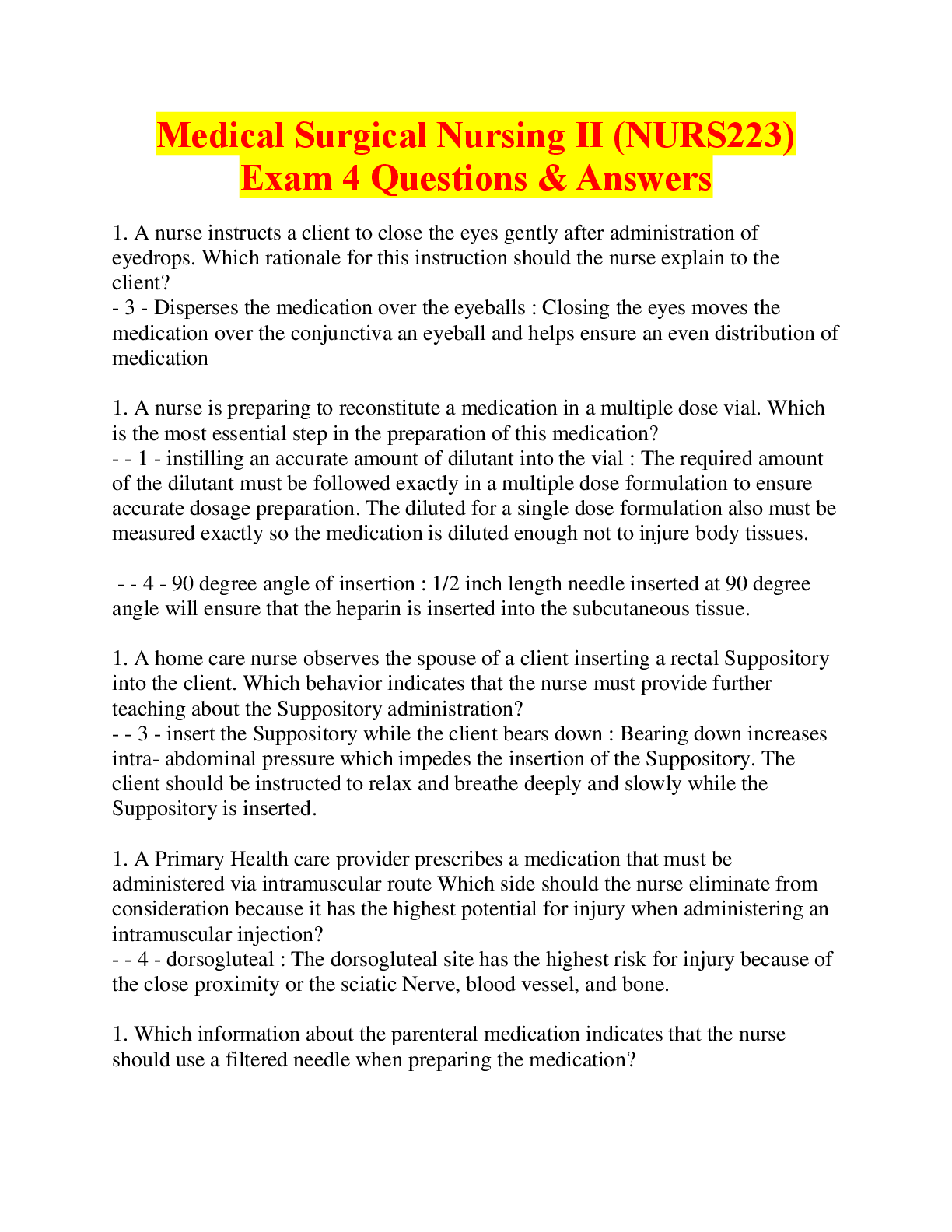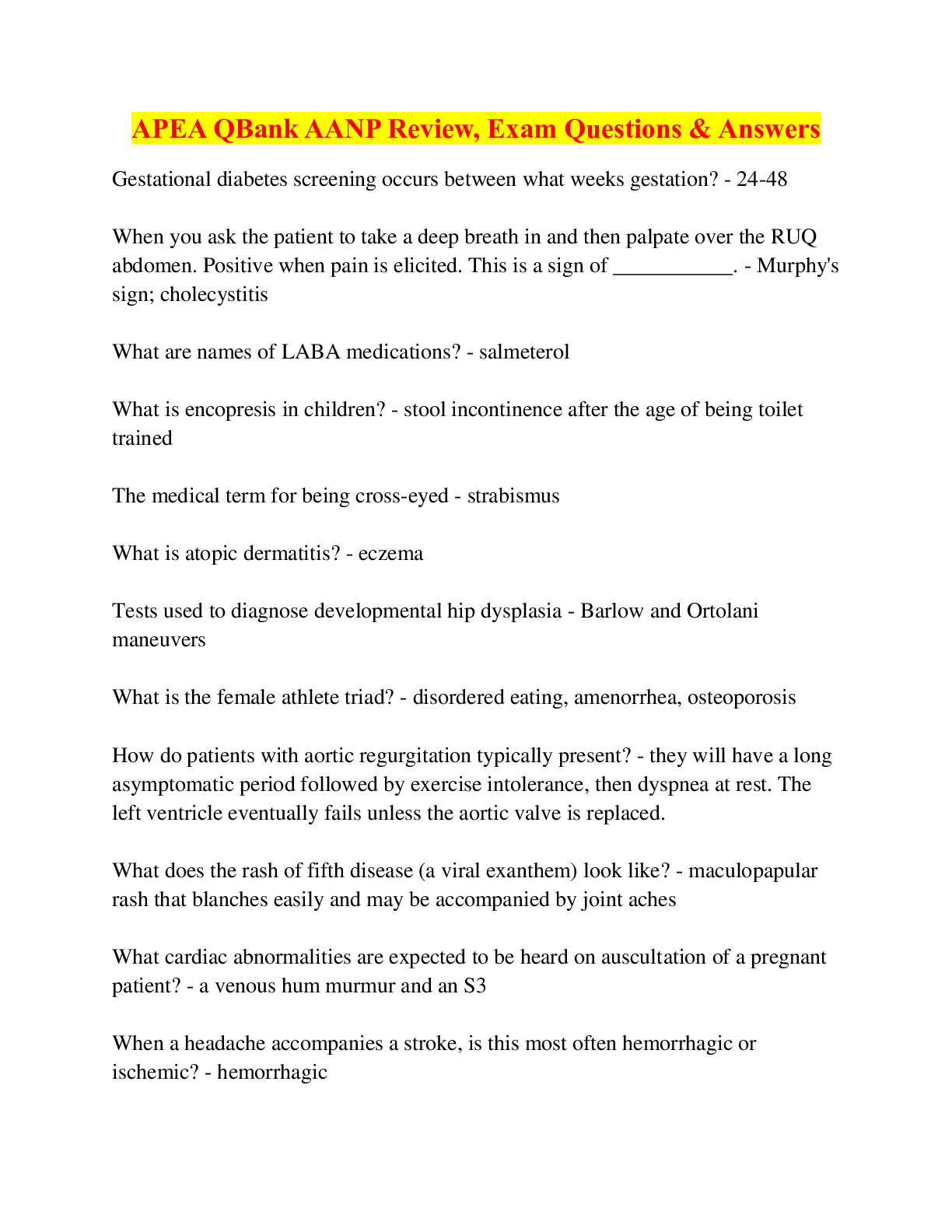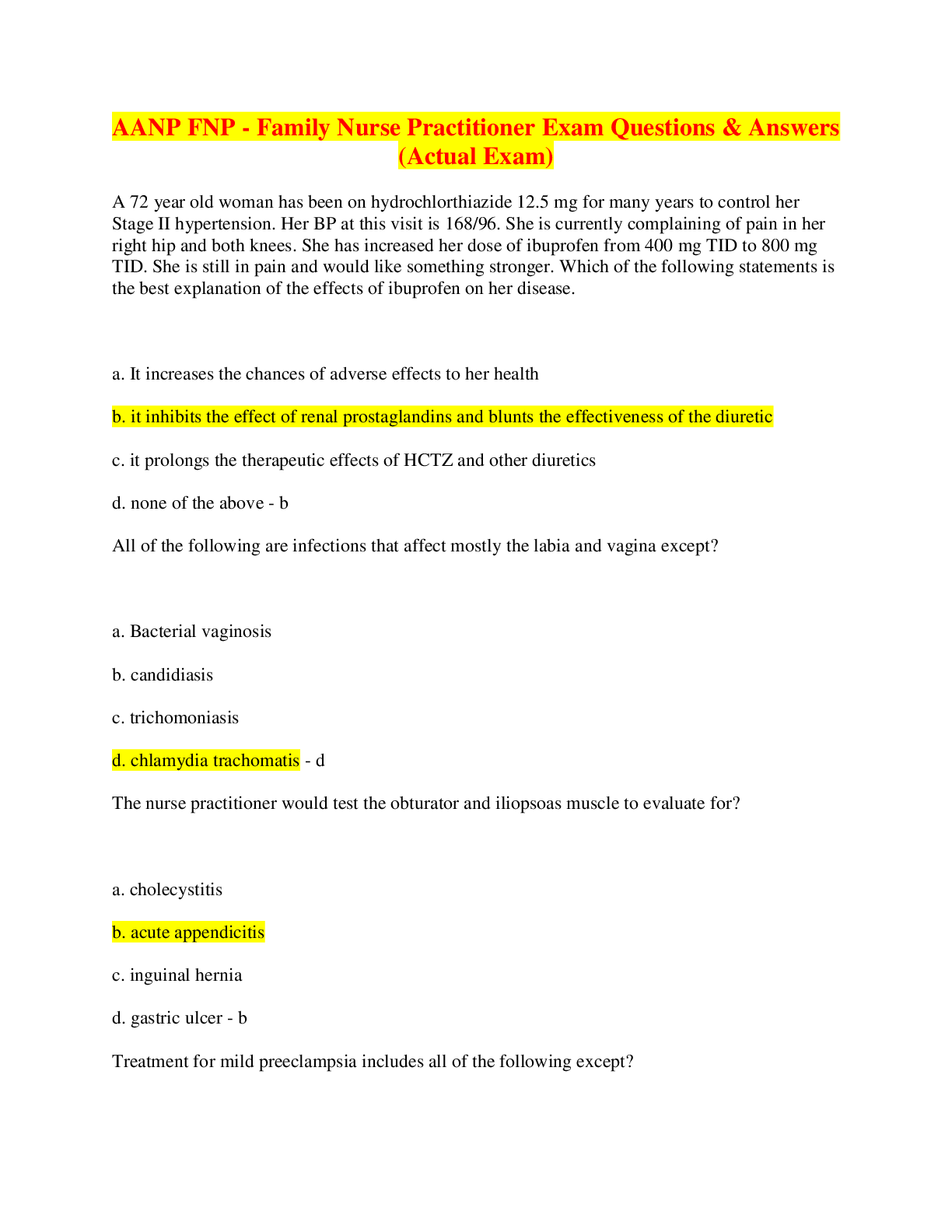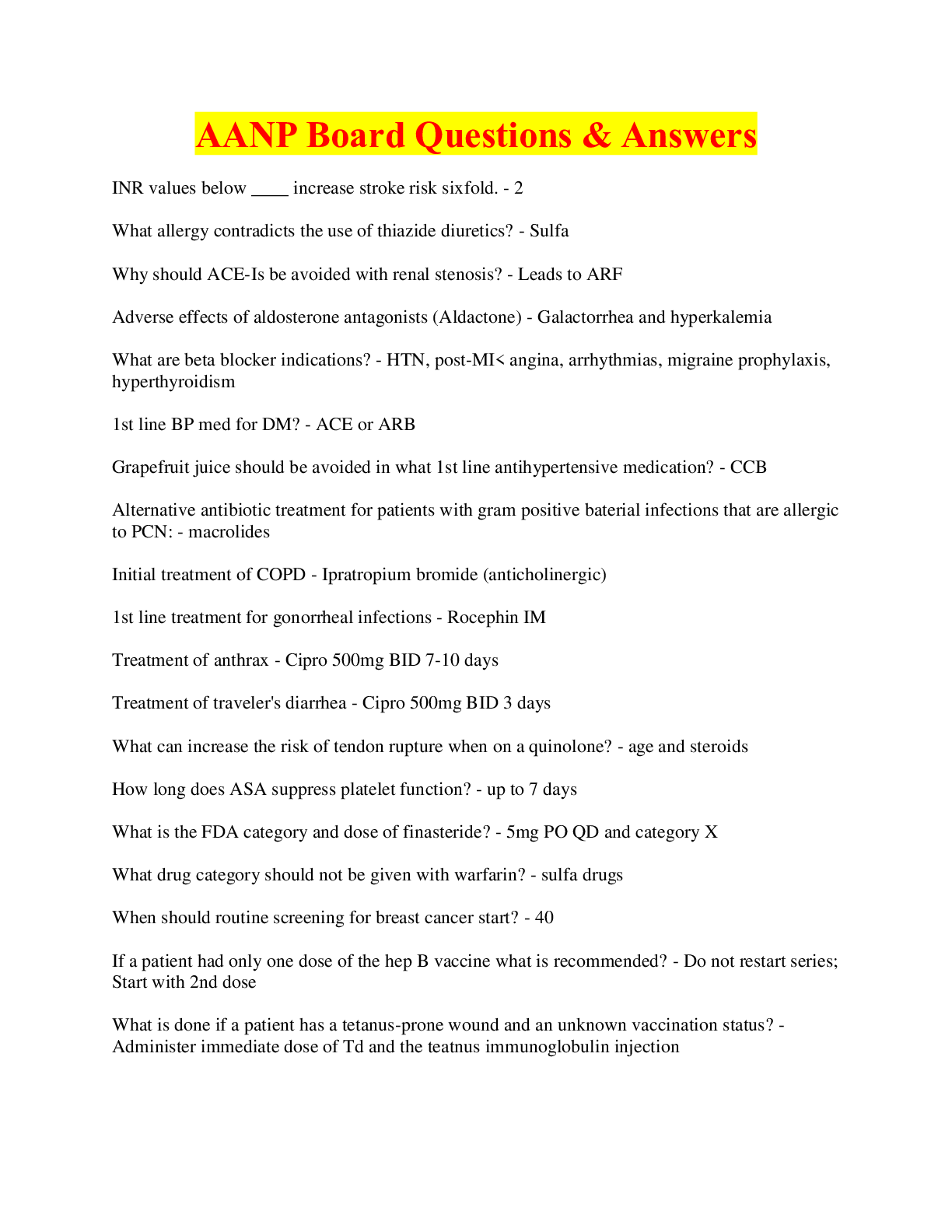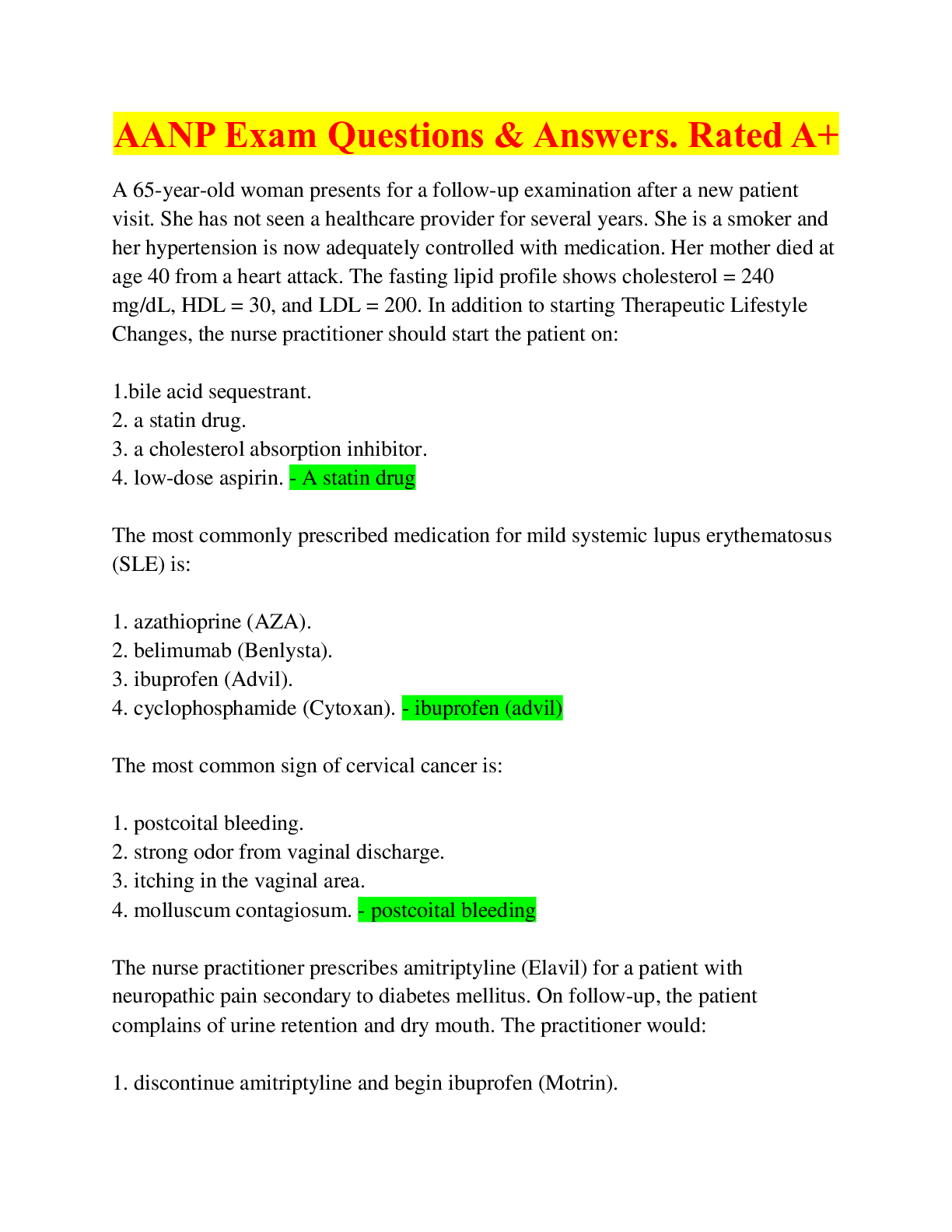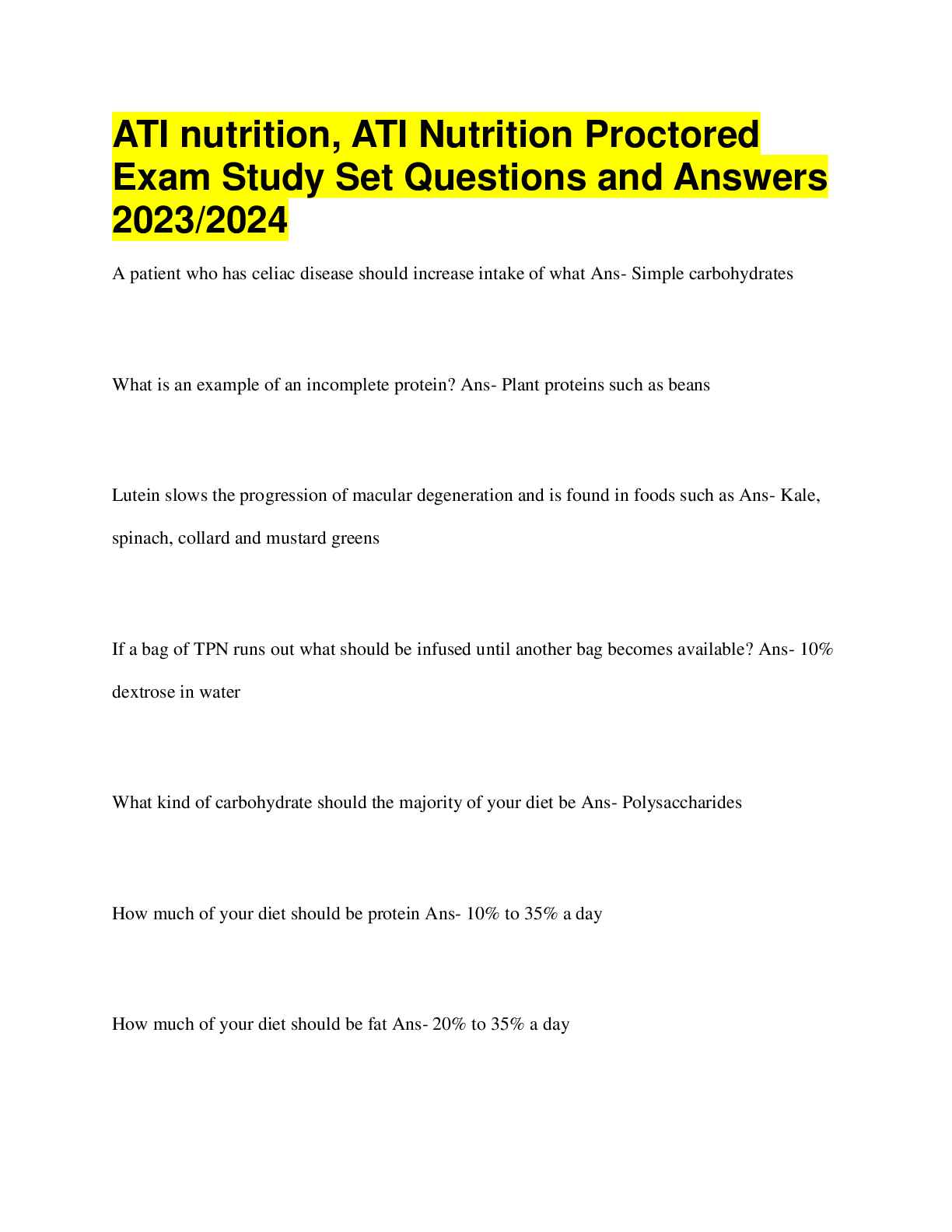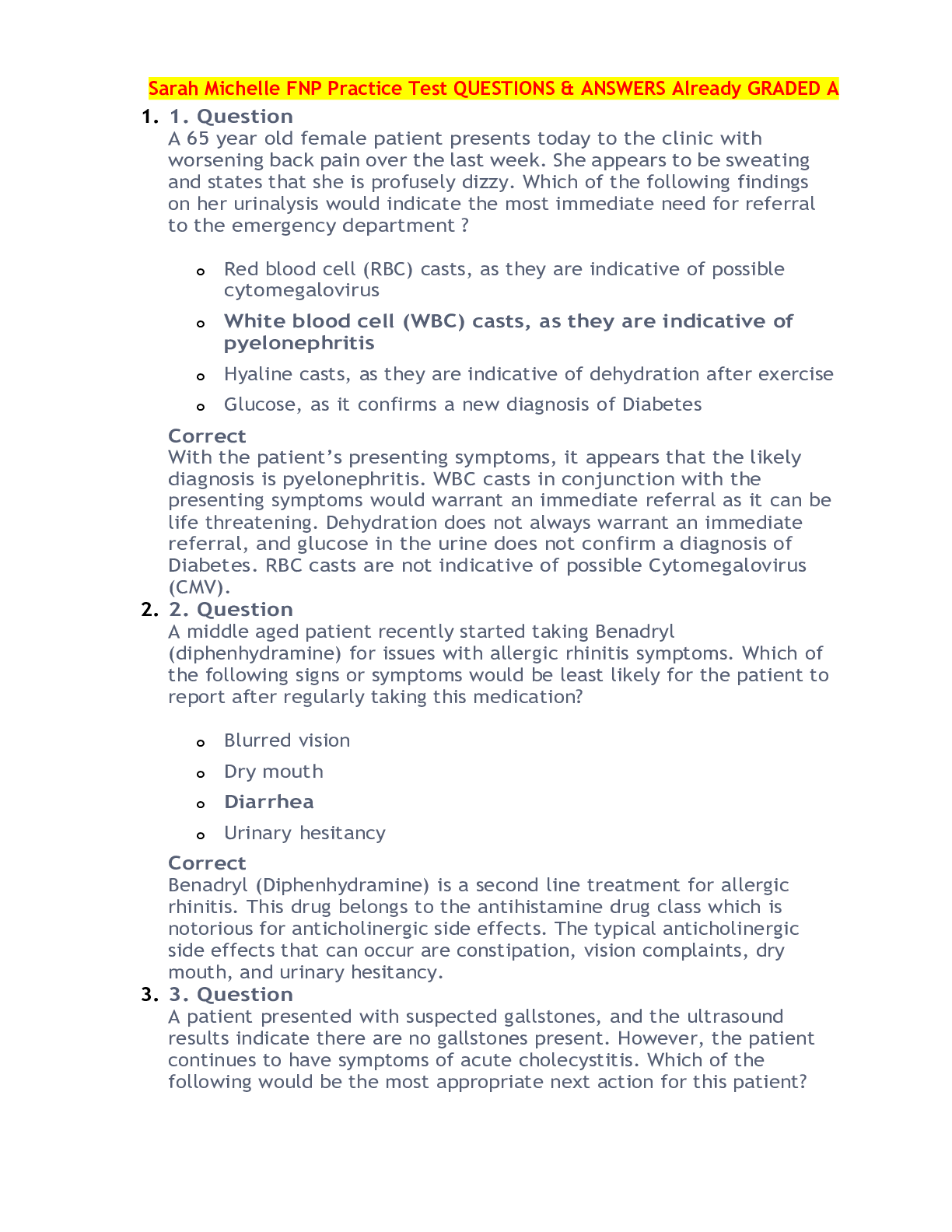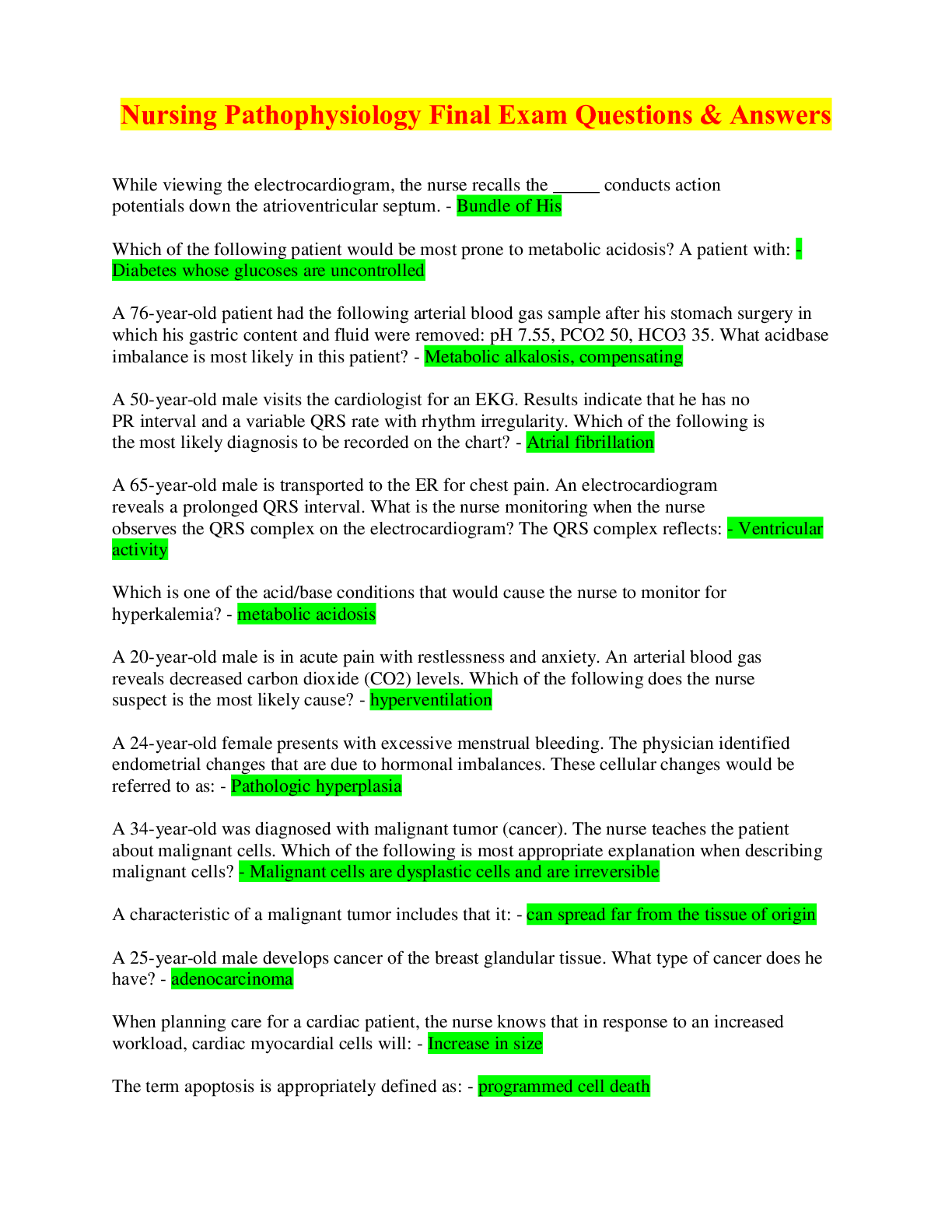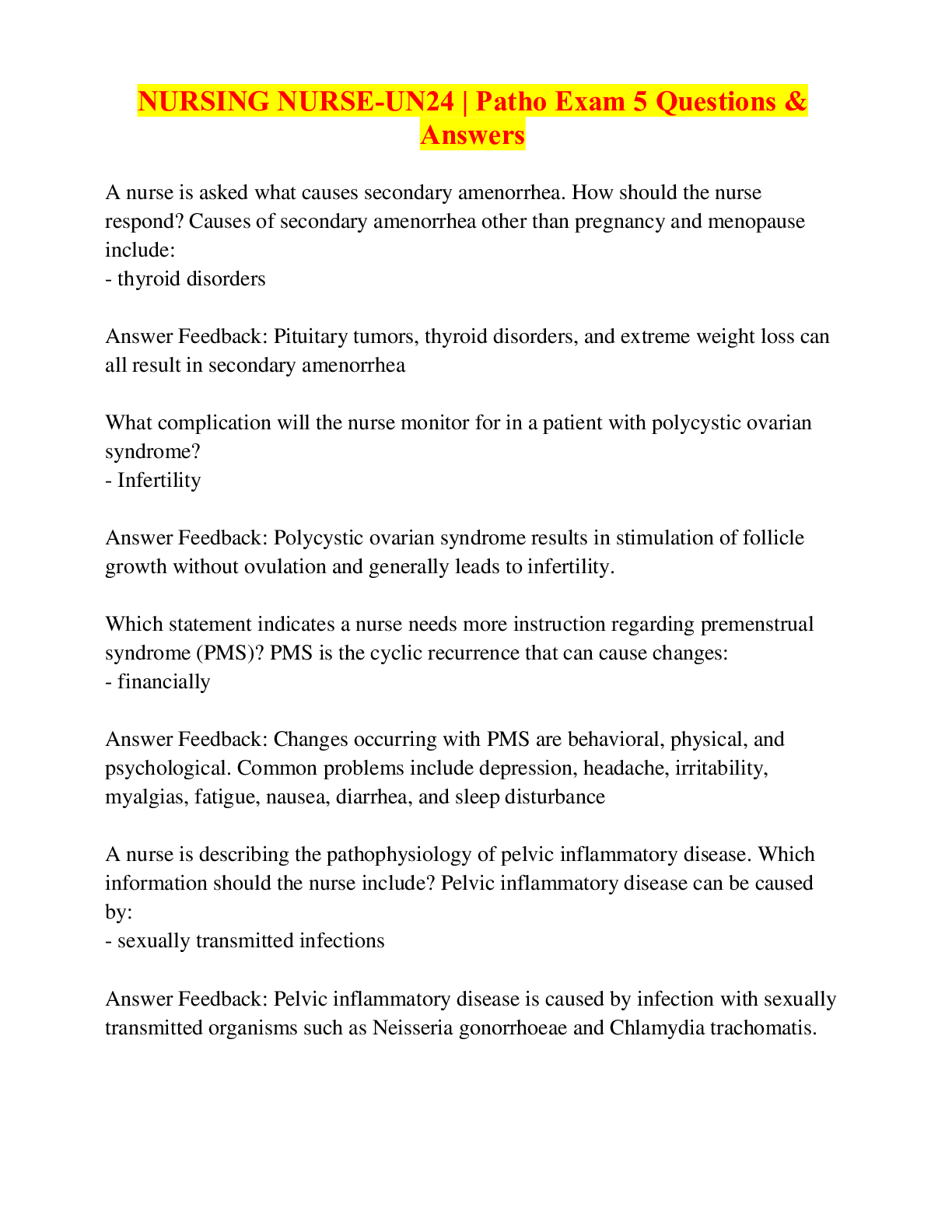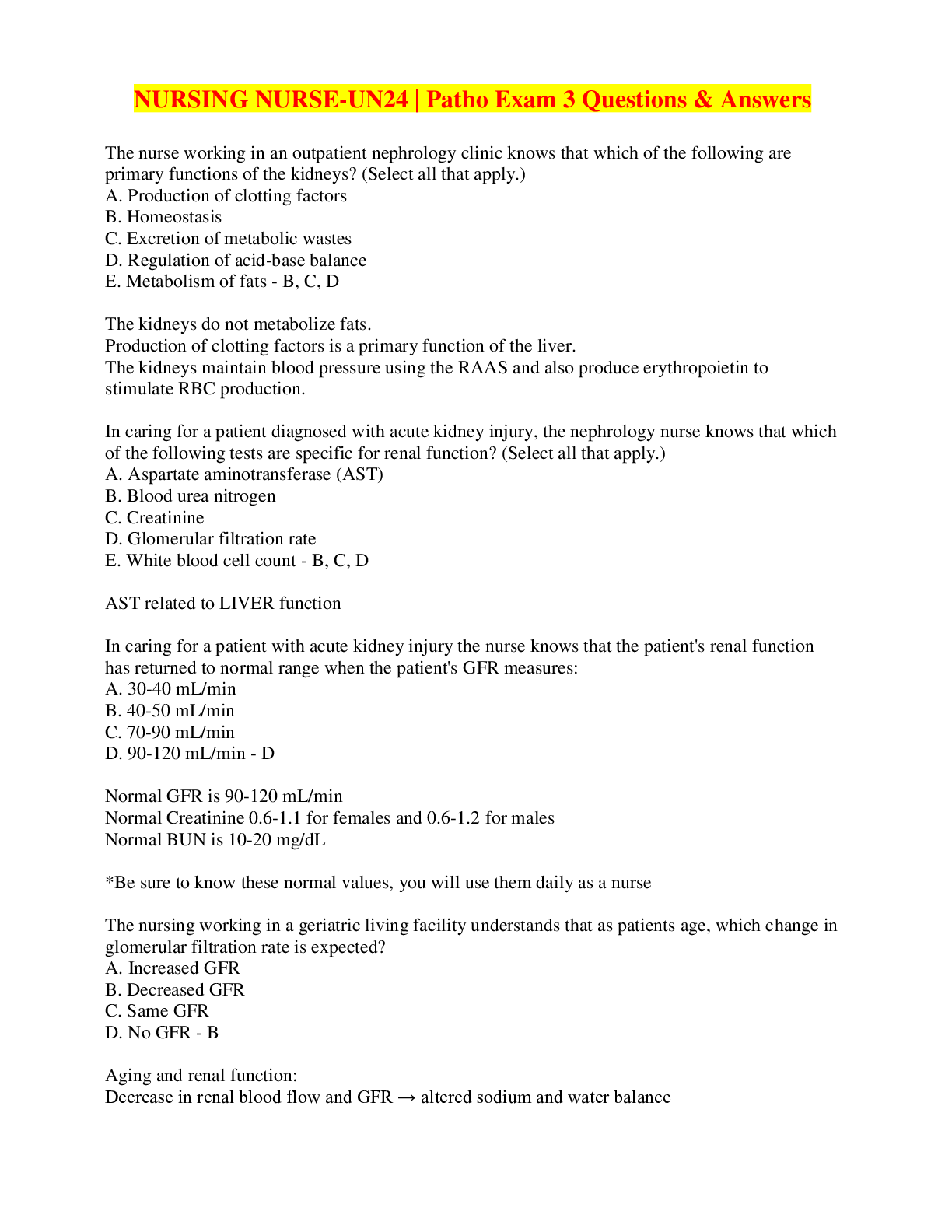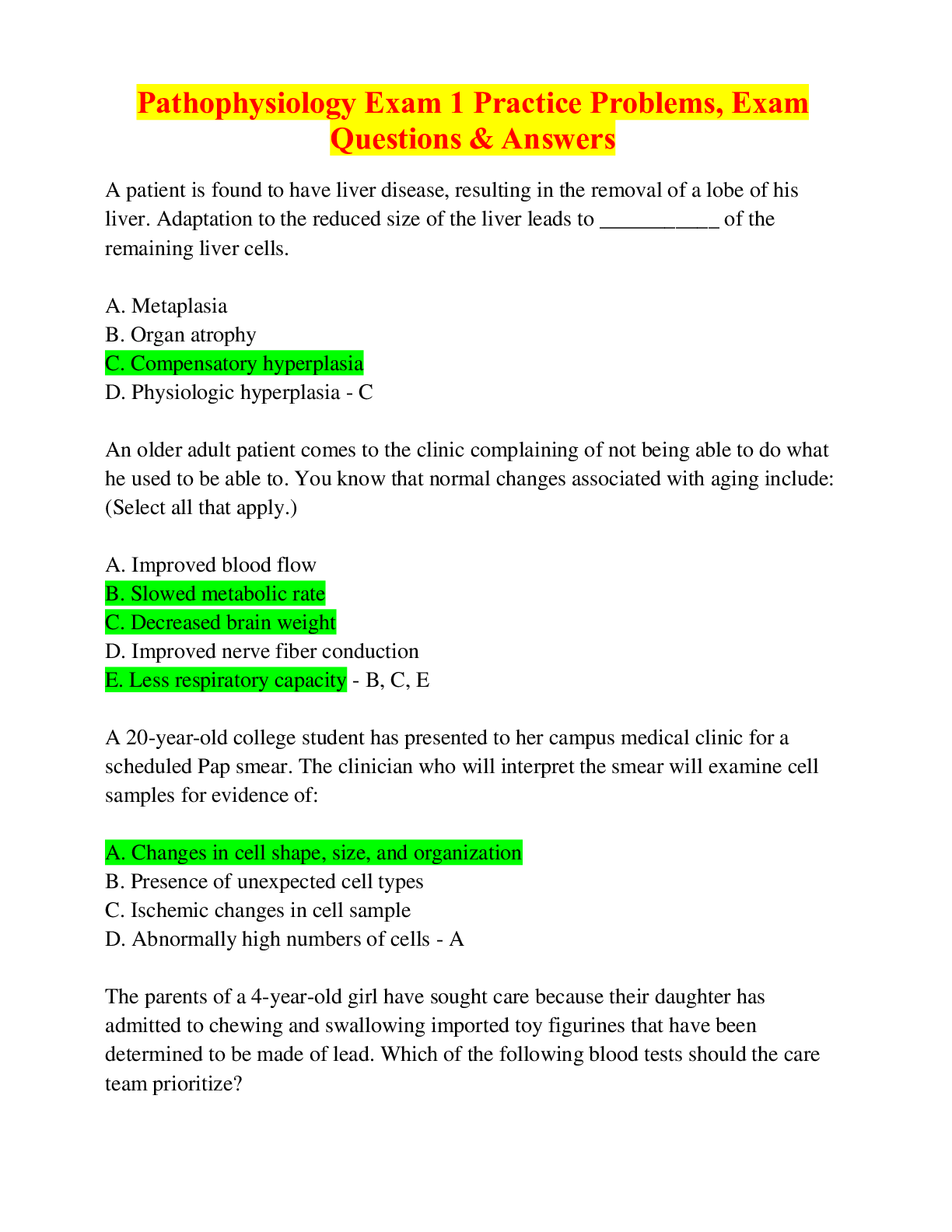*NURSING > EXAM > Nursing Care of Infants and Children Final Exam Questions with Explained Answers, Rated 100% (All)
Nursing Care of Infants and Children Final Exam Questions with Explained Answers, Rated 100%
Document Content and Description Below
Nursing Care of Infants and Children Final Exam Questions with Explained Answers, Rated 100%-A 10-year-old child suffered extensive second- and third-degree burns in an apartment fire. His weight is 7... 5 lb (34 kg). Fluid replacement therapy will optimally: A. Result in an hourly urine output of 1 mL/kg B. Result in an hourly urine output of 20 mL/kg C. Result in an hourly urine output of 30 mL/kg D. Maintain a systolic BP in the 95th percentile for the child's weight Chapter 23 - C. Result in an hourly urine output of 30 mL/kg A 10-year-old child with a peanut allergy would be expected to have which of these as an early manifestation of his allergy? SATA A. Wheezing B. Nausea C. Headache D. Trouble breathing E. Urticaria Chapter 11 - A. Wheezing D. Trouble breathing E. Urticaria A 12-year-old child is in the urgent care clinic wiht a complaint of fever, headache, and sore throat. A diagnosis of group A B-hemolytic streptococcus (GABHS) pharyngitis is established with a rapid-strep test, and oral penicillin is prescribed. The nuse knows that which of the following statements about GABHS is correct? A. Children with GABHS infection are less likely to contract the illness again after the antibiotic regimen is completed. B. A follow-up throat culture is recommended after the completion of antibiotic therapy. C. Children with a GABHS infection are at increased risk for the development of rheumatic fever and glomerulonephritis. D. Children with a GABHS infections are at increased risk for the development of rheumatoid arthritis in adulthood. Chapter 26 - C. Children with a GABHS infection are at increased risk for the development of rheumatic fever and glomerulonephritis. A 12-year-old who was in an ATV accident has a long-leg fiberglass cast on his left leg for a tibia-fibula fracture. He requests pain medication at 2:00 am for pain he rates at a 10/10 on the numeric scale. The nurse brings the pain medication and notes that he has removed the pillows that keep his leg elevated. He complains of pain in the left foot, and she notes that there is 3+ edema in the exposed leg and foot and she is unable to slip a finger under the cast. The nurse's priority interventions in this situation should include: A. Administer the pain medication and elevate the child's leg on the pillows B. Elevate the leg on the pillows and follow up within 2 to 3 hours to see if the edema has decreased C. Let the child know he cannot have any additional pain medication until 6:00 am D. Notify the surgeon of the findings immediately Chapter 33 - D. Notify the surgeon of the findings immediately A 14-year-old male with a spinal cord injury is placed on a standing table and suddenly begins to sweat profusely and complains of a headache. The nurse takes a set of vital signs and notes a significant increase in systolic blood pressure and a HR of 50 bpm. The most helpful intervention in this situation would be for the nurse to: A. Place the adolescent back in his wheelchair and take him to his room. B. Palpate the bladder for distention. C. Administer a routine analgesic for his headache and discontinue the therapy. D. Place the standing table in a horizontal position and allow the adolescent to rest for a few minutes. Chapter 34 - B. Palpate the bladder for distention. A 15-year-old female diagnosed previously with anorexia nervosa is admitted to the ER. Her mother states that her daughter has not voided in 24 hours and has been lethargic for the last 12 hours. The patient appears cachectic and pale, and her weight is recorded as 78 lb. She is minimally responsive to painful stimulation. A number of diagnostic tests are obtained. Which one of the these represents the most immediate threat to her life requiring intervention? A. Serum sodium of 149 mEq B. Serum potassium of 2.6 mEq C. Hemoglobin of 6.8 D. Arterial pH of 7.30 Chapter 18 - B. Serum potassium of 2.6 mEq A 16-month-old has a history of diarrhea for 3 days with poor oral intake. He received IV fluids, has tolerated some oral fluids in the ED, and being discharged home. Instructions for diet for this child should include: A. BRAT diet (bananas, rice, applesauce, and toast) for 24 hours, then a soft diet as tolerated. B. Chicken or beef broth for 24 hours, then resume a soft diet C. Offer a regular diet as child's appetite warrants D. Keep on clear liquids and toast for 24 hours. Chapter 25 - C. Offer a regular diet as child's appetite warrants A 2-day-old infant in the newborn nursery is diagnosed with developmental dysplasia of the hip, and treatment is started by the orthopedist. The nurse assists the parents by providing home care instructions that include: A. Return to the orthopedist's office in 2 weeks to remove the hip spica cast. B. The infant's bilateral foot casts should be elevated on pillows as much as possible. C. Remove the Pavlik harness once a day for no more than an hour and inspect skin. D. Remove the Pavlik harness while the infant is awake to allow "tummy time." Chapter 33 - C. Remove the Pavlik harness once a day for no more than an hour and inspect skin. A 2-month-old formerly healthy infant born at term is seen in the urgent care clinic with intercostal retractions, RR of 62, HR of 128, refusal to breastfeed, abundant nasal secretions, and a pulse oximeter reading of 88% in room air. The diagnosis of RSV is made. The infant's oxygen saturation remains 95% in room air, and the RR is 54, with intercostal retractions; HR is 120 bpm. After 2 hours of observation and an intravenous bolus of fluids, the infant is being discharged home. The nurse provides which of the following home care instructions for this infant? SATA A. Continue breastfeeding the infant. B. Discontinue breastfeeding and administer Pedialyte for 24 hours. C. Observe infant for labored breathing or apnea (cessation of breathing). D. Instill normal saline drops in both nares and suction thoroughly before feeding and before placing to sleep. E. Place infant to sleep on his side with the head of bed slig - A. Continue breastfeeding the infant. C. Observe infant for labored breathing or apnea (cessation of breathing). D. Instill normal saline drops in both nares and suction thoroughly before feeding and before placing to sleep. F. Keep the infant out of day care or nursery. A 3-month-old infant is seen in the clinic with the following symptoms: irritability, crying, refusal to nurse for more than 2 to 3 minutes, rhinitis, and a rectal temp of 101.8 F. The labor, delivery, and postpartum history for this term infant is unremarkable. The nurse anticipates a diagnosis of: A. Acute otitis media (AOM) B. Otitis media with effusion (OME) C. Otitis externa D. Respiratory syncitial virus (RSV) Chapter 26 - A. Acute otitis media (AOM) A 3-month-old is being seen in the well-child clinic for positional plagiocephaly. The nurse knows that the initial interventions for this condition involve which of the following? SATA A. Place the infant to sleep in the prone position. B. Place the infant in a prone position when awake (approximately 15 minutes). C. Alternate the infant's head position (side of head) when asleep. D. Have the infant wear a soft helmet for 23 to 24 hours a day. E. Place the infant to sleep in an infant seat twice a day. Chapter 11 - B. Place the infant in a prone position when awake (approximately 15 minutes). C. Alternate the infant's head position (side of head) when asleep. [Show More]
Last updated: 7 months ago
Preview 5 out of 61 pages

Loading document previews ...
Buy this document to get the full access instantly
Instant Download Access after purchase
Buy NowInstant download
We Accept:

Reviews( 0 )
$15.50
Can't find what you want? Try our AI powered Search
Document information
Connected school, study & course
About the document
Uploaded On
Dec 16, 2024
Number of pages
61
Written in
Additional information
This document has been written for:
Uploaded
Dec 16, 2024
Downloads
0
Views
11

